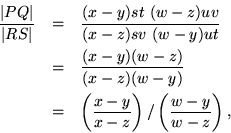Consider the projective line as an image of a two-dimensional linear algebra plane, and observe that determinants are multiplicative for linear transformations. Take a ![]() matrix
matrix ![]() containing the two columns of a basis and a transformation
containing the two columns of a basis and a transformation ![]() . Then
. Then ![]() , so
, so ![]() is not an invariant. But take another basis matrix
is not an invariant. But take another basis matrix ![]() for which
for which ![]() . Then the quotient
. Then the quotient ![]() is invariant, although its terms are not.
is invariant, although its terms are not.
 |
Carrying the result over to the projective line, write the matrices in projective form
Although this quotient is invariant enough, the multipliers would normally be unknown. Choosing more vectors and dividing once again would only create more multipliers, but the same multipliers can be kept by just rearranging the four vectors in the two bases. There are twenty four possibilities, the permutations of four objects, but only some of them produce the cancellation which would free the points from the multipliers.
The nice symmetry of the formula shows how to get the cancellation; note that each difference is multiplied by the product of its two multipliers. Making up a product of four multipliers in two different ways would allow cancelling the unknown factors while retaining the differences in the points themselves.
So make up two new matrices,
